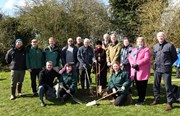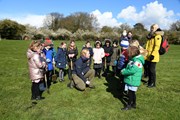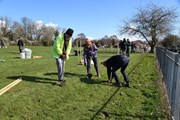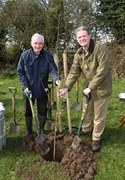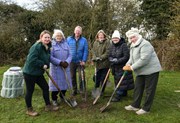
01 Apr 2022
Humber Forest relaunched with ceremonial tree planting in Beverley
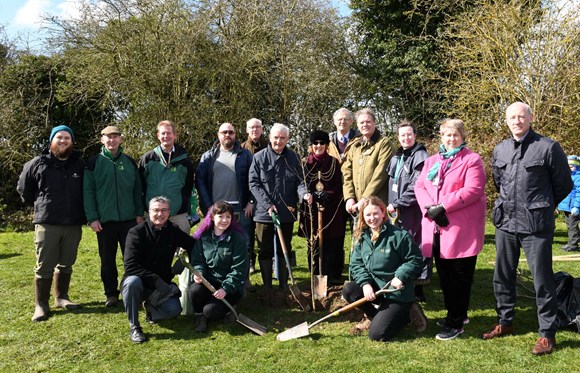
Humber Forest (previously known as HEYwoods) have celebrated their relaunch this week at one of their many tree planting projects in the East Riding area.
The project, which was brought forward by the Beverley Civic society and led by local charity The Conservation Volunteers, saw the planting of 1050 trees at the Archery Fields, Beverley. Planting was assisted by volunteers from the local community and children from Beverley Minster Primary School.
Also in attendance to celebrate the relaunch and helping with the planting was Cllr Nigel Wilkinson, chairman of East Riding of Yorkshire Council, Beverley Town Mayor Linda Johnson, Crispin Thorn, Forestry Commission Area Director for Yorkshire and North East, representatives from Defra (Department for Environment Food & Rural Affairs), along with portfolio holder for environment and climate change at East Riding of Yorkshire Council, Cllr Chris Matthews, and a representative from Hull City Council.
HM Lord-Lieutenant of East Riding of Yorkshire, Jim Dick OBE was present as the Queen’s personal representative, as the site will be used to contribute to The Queens Green Canopy. The QGC is a UK-wide tree planting initiative which encourages people to plant a tree to commemorate the Queen’s Platinum Jubilee this year.
Humber Forest partners The Forestry Commission, The Woodland Trust and many more attended the planting and the public “drop in” session that allowed anyone to come and ask any questions they have about community forestry, woodland creation and tree planting.
The Humber Forest is not a single ‘forest’ covering an area, but the collection of many trees, woodlands and hedgerows across the East Riding of Yorkshire and Hull.
Previously known as HEYwoods, Humber Forest works together with communities, businesses, and landowners to increase tree cover and maintain existing woodland. It connects people and woodlands for happier and healthier communities, helping tackle climate change, and improving the local environment for all. It provides advice and guidance, access to funding, and project support for landowners, businesses and communities wanting to plant trees, woodlands, and hedgerows in the area.
Humber Forest partners with both East Riding of Yorkshire and Hull City Councils, Defra, The Forestry Commission, The Woodland Trust, The Community Forest Trust and others to create a ‘one team approach’ to tree-planting projects.
Cllr Wilkinson, chairman of East Riding of Yorkshire Council, said: “Tackling the climate emergency remains a great challenge, so we are incredibly excited to relaunch Humber Forest which will play an enormous part in creating more sustainable communities for us to live in for generations to come.
“The pandemic has shown us just how important our parks, gardens and green spaces are and, when planted in the right place, the new woodlands and hedgerows will bring huge benefits, from boosting biodiversity, creating homes for wildlife, improving air quality, reducing the risk of flooding, and making a positive impact on people’s health and wellbeing.
“East Riding of Yorkshire Council is committed to achieving net zero through reducing its own carbon emissions across council operations, and by working with communities and organisations to influence behaviours and ambitions on climate change across the county. Now part of the Humber Community Forest, we can continue in our efforts to provide a greener and cleaner future for everyone.”
Cllr Matthews, portfolio holder for climate change at East Riding of Yorkshire Council, added: “We're delighted to support this initiative as we know planting trees goes a long way towards tackling the effects of climate change and biodiversity loss, while creating more green spaces for everyone to enjoy.
“The fact is there are simply not enough trees to tackle the climate emergency, so we need plant more in the right places as quickly as possible and protect those we already have.
“The Humber Forest is a great example of how we can help turn around the effects of climate change and make a big difference, while also making the region a happier, healthier and more beautiful place to live for future generations.”
Crispin Thorn, Area Director for Yorkshire and the North East at Forestry Commission said: “Forestry Commission are a long-term supporter and partner in the community forest and we are delighted to support this relaunch.
“The Forest of Humber will bring huge local benefits as well as play a key role in supporting the delivery of the national ambition for woodland creation. We’re proud to support the initiative and look forward to working with partners to deliver on the ground.”
This planting season, Humber Forest will have funded the planting of 72,320 trees within woodlands and hedgerows on 48 sites (18.81 hectares of woodland, 3527metres of hedgerow, 125 standards, total area planted this year 21.4ha).
Next year, the scheme aims to plant 90 hectares of hedgerow and woodland across Hull and the East Riding. This will equal around 270,000 trees.
Leah Hallas, the Humber Forest manager, said: “The new rebrand brings the community forest in line with our ambitions and targets for the future years. HEYwoods was our roots, but with a brand-new team, we have grown into something new and exciting.”
For anyone who would be interested in planting on their land, or who would like to find out more information, please visit www.humberforest.org or contact humber.forest@eastriding.gov.uk
Contact Information
Sam Holtby
Public Relations Officer
East Riding of Yorkshire Council
07791259055
samuel.holtby@eastriding.gov.uk
Notes to editors
Notes for Editors
What is a Community Forest?
Community Forests are not a single woodland, but a network of trees, woods and forests and greenspaces across a defined area, weaving through urban areas and wrapping around communities.
Community Forests are located in and around England’s largest towns and cities and they exist to connect urban populations to the wider landscape; helping to tackle climate change, improve well-being, strengthen communities and local economies and create spaces for nature.
Collectively, the work of the Forests has formed the largest environmental regeneration initiative in England. For thirty years the teams working to deliver the forests have enabled urban, economic and social regeneration, championing green infrastructure and creating high-quality environments for millions of people. By planting trees and bringing woodlands back into use for both people and wildlife the forest teams continue to provide new opportunities for leisure, recreation and cultural activities, enhancing biodiversity, building resilience to climate change and improving education and healthy lives.
Where are the Community Forests located?
There are 13 Community Forests across England:
- The Forest of Marston Vale, Bedfordshire
- Great Western Community Forest, covering the North Wessex Downs to the River Thames
- The Greenwood Community Forest, west Nottinghamshire
- The Mersey Forest, which covers Merseyside and North Cheshire
- City of Trees, Greater Manchester
- Forest of Avon Trust, which covers Bristol and Avon
- Humber Forest (previously HEYwoods) Community Forest
- Thames Chase Trust, which covers East London and South West Essex
- White Rose Forest, which covers Leeds city region and North and West Yorkshire
- Forest of Mercia, which covers Staffordshire and the West Midlands
- Plymouth Community Forest, Plymouth and South Devon
- North-East Community Forest
- Cumbria Coastal Community Forest
To see where each of the Community Forests in England are, and to learn more about them individually, click here
What are the aims of the Community Forests collectively?
- Support regeneration and growth - Making towns and cities more attractive places in which to live, work and do business; attracting new investment and creating jobs
- Support local communities - Harnessing the enthusiasm, commitment, and knowledge of local people; helping them improve their local area and enhancing health and wellbeing
- Creating Better Places – Enriching and enhancing biodiversity the environment, creating new facilities for recreation and leisure and making our towns and cities more sustainable
What have Community Forests achieved so far? (2021)
- For thirty years the Community Forests have delivered urban, economic and social regeneration, championing green infrastructure and creating high-quality environments for millions of people. The Forests are within reach of 50% of the population of England and in areas where community forestry can have the most socio-economic impact. Together they have:
- Planted over 15,000 hectares of new woodland
- Brought over 27,000 hectares of existing woodland under management
- Created over 25,000 hectares of non-woodland habitat
- Opened up 16,000 hectares of woods and green space for recreation and leisure
- Restored or built over 4,000 kilometres of footpath, bridleways and cycle routes
- Created and restored nearly 3,000km of hedgerows
Why are you renaming HEYwoods to Humber Forest?
Humber Forest (previously known as HEYwoods) is the Community Forest for Hull and East Yorkshire. They work together with communities, businesses, and landowners to increase tree cover and maintain existing woodland. Connecting people and woodlands for happier and healthier communities, helping tackle climate change, and improving the local environment for all. The Humber Forest is not a single ‘forest’ covering an area, but the collection of many trees, woodlands and hedgerows across the East Riding of Yorkshire and Hull.
They work with both East Riding and Hull City Council, Defra, The Forestry Commission, The Woodland Trust, The Community Forest Trust and others to create a ‘one team approach’ to tree-planting projects.
How can an area/city apply to become a Community Forest?
Community Forests exist where the need is greatest; in areas of tree cover is lower and often where there are social and economic inequalities. England’s Community Forests is an ambitious partnership and encourages the growth of community forestry wherever it can bring about meaningful change; a process has been developed to support enquiries from other areas, including guidance to support a pitch. Please visit https://englandscommunityforests.org.uk/ for more information.
What is the Trees for Climate programme?
Trees for Climate is a bold new programme funded through Defra’s Nature for Climate Fund that will deliver over 6,000 hectares of new tree and woodland cover across England by March 2025, capturing around two million tonnes of carbon.
What is the Nature for Climate Fund?
The Nature for Climate Fund (NCF) was announced in Spring 2020. This is a £640m fund to greatly increase tree planting in England and peatland restoration over this Parliament to support the delivery of the England Trees Action Plan, as well as the England Peat Action Plan.
What is The Queen's Green Canopy?
The Queen’s Green Canopy (QGC) is a unique tree planting initiative created to mark Her Majesty’s Platinum Jubilee in 2022 which invites people from across the United Kingdom to “Plant a Tree for the Jubilee”. Everyone from individuals to Scout and Girlguiding groups, villages, cities, counties, schools and corporates will be encouraged to play their part to enhance our environment by planting trees during the official planting season between October to March. Tree planting will commence again in October 2022, through to the end of the Jubilee year. With a focus on planting sustainably, the QGC will encourage planting of trees to create a legacy in honour of The Queen’s leadership of the Nation, which will benefit future generations. To find out more visit The Queen’s Green Canopy (queensgreencanopy.org)
